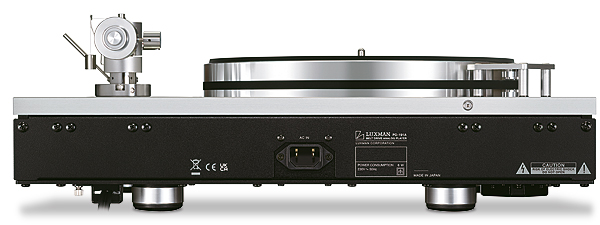Luxman PD-191A Turntable Page 2
Good Company
What I was overjoyed to hear were the results of an unintended experiment. Armed with a selection of the Atlantic 75 reissues on clear vinyl, I enjoyed long sessions with the new clear pressing of Bad Company's eponymous debut album [Swan Song RCV1 8410]. Despite exuding refinement, the PD-191A elicited irresistible air-guitar playing from the opening notes of 'Can't Get Enough'.
As is mandatory with hard rock of this calibre, the sound had exactly the levels of 'weight' that define both heavy metal music and a heavy-plinth turntable. The solidity, especially in the bass guitar, also reinforced the lower octaves of each cartridge, at times even approaching the reach of mid-level DS Audio optical models – the champions in this area. The power chords also possessed precisely the force this material demands.
Back In Black
Where it became interesting was in comparing two pressing types, which I had never actually bothered to do before. Such was the openness, transparency and detail retrieval afforded by this flagship Luxman deck that I figured I would compare the new, clear pressing with my black vinyl originals. The validity of this test is questionable as I am sure the new release has been remastered, while the original came from younger master tapes.
Still, what intrigued me was a question that some hardcore vinyl addicts love to debate: is black vinyl better than clear, as its carbon component serves as a lubricant, even though transparent vinyl is the material's natural state? I had three black vinyl versions of Swan Song dating back to 1974 as well as the new pressing, and while I couldn't arrive at an answer to the black/clear conundrum all sounded unalike thanks to the PD-191A deftly exposing their differences.

With this high level of forensic revelation, I was driven to compare One-Steps versus other pressings, especially as I own six pressings of Crosby Stills & Nash including the original US release [Atlantic SD-8229], the Japanese pressing [Atlantic P-10122A], the 2023 clear vinyl Atlantic 75 reissue [RCD1 8229] and the Mobile Fidelity One-Step [UD1S 2-021]. I did this not to find out which sounded the best – a matter of taste, surely? – but to test the PD-191A's powers of analysis.
Perfect Harmony
This 1969 album is all about harmony, and – depending on the pressing – it was the separation of the voices that varied the most. This was down to the LPs, not Luxman's turntable, but its contribution to the sessions was allowing me to hear the differences. And what proved as valuable as the harmonies was hearing each lead vocal, by now any fan of 1960s US West Coast rock being deeply familiar with the nature of Stephen Stills', David Crosby's and Graham Nash's voices.
There were nuances galore. Stills' slight rasp, the airiness of Crosby blending with Nash while both remained distinct... the PD-191A drove me to fire up my diminutive LS3/5As just to focus on the midband. As much as it dazzled me with the bottom reaches and its analytical capabilities, the deal-maker is the authenticity of voices. (OK, stop twisting my arm: the US original sounds the best…)
Still obsessing over vinyl colours but concentrating on vocals, I pulled out both the black and clear vinyl pressings of what we're told is The Beatles' final single, the 7in 'Now And Then' [Apple 4814586]. In addition to running at 45rpm and showing me how stable it was, it let me dissect the B-side, which is of far more interest – the AI-regenerated stereo version of 'Love Me Do'. Leaving aside the shock of it sounding so unlike the familiar original, it was a lesson in how studio boffins are going to tamper with classic recordings. With the LP version also available [Apple 0602455920805], I could also compare 33.3rpm with 45rpm.
Message Received
What did it show me? That the Luxman PD-191A turntable placed John Lennon right in the middle of my listening room. Sadly, the cassette from which it was remastered isn't available to us to hear what Giles Martin managed to retrieve, but I did learn of the one weakness in the Luxman PD-191A: even this superlative turntable could not make me ever want to hear again this unfortunate and unsuitable coda to the greatest canon of popular music. But I'm not about to shoot the messenger…
Hi-Fi News Verdict
Easy on the eye, at first glance as conventional as any deck-in-a-plinth one can name, but the Luxman PD-191A is as deceptive as it is heavy. This turntable is the LP spinner I would recommend to all music lovers who want superb sound but without the torture associated with (some) esoteric gear. I tell you this: if I had the money and the need for a deck, this would be in the top five of my shortlist. It's simply sublime.
























































